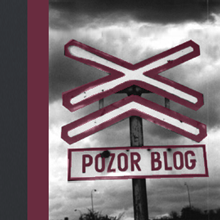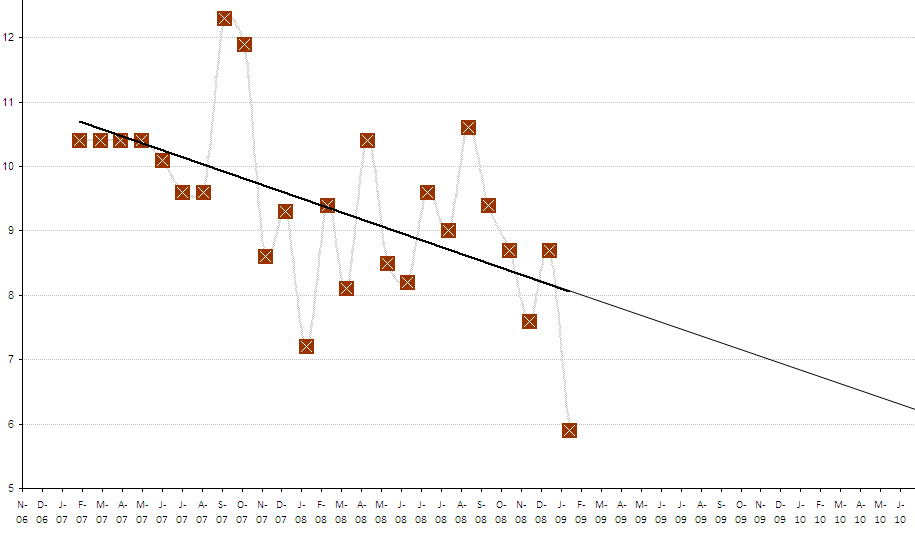There is an old Communist-era joke in which one character asks the other, “Why weren’t you at the last party meeting?” and the other responds “If I had known it was the last party meeting, not only would I have shown up but I would have brought a bottle of champagne.” In a similar–if more unfortunate vein–when I talk about the last UVVM survey of public opinion in Slovakia, I mean the last one. The Statistical Office of the Slovak Republic has stopped the monthly public opinion polling on parties that gave Slovakia one of the most robust public-opinion tracking data of any country in postcommunist Europe. The office has been discussing this for over a year (the director of the office, Ludmilla Benkovicova, discussed this with me in an interview in June 2008 and it was in the air well before then) but it is awkward for all concerned that the polling ceased precisely at a point when, according to a report by Pravda (http://spravy.pravda.sk/hzds-a-sns-nepadli-popularitu-straca-len-smer-faz-/sk_domace.asp?c=A090425_120119_sk_domace_p23) the ruling party, Smer, allegedly received its lowest support in over a year-and-a-half, and the ruling coalition allegedly received its lowest support since the June 2006 election. I write “allegedly” because in addition to ending the party preference polls, the Statistical Office also embargoed the results of April poll that included those numbers and we have them in the public realm only because Pravda claims to have obtained a copy (which it also claims that Benkovicova did not deny).
It is hard to know what to make of Benkovicova’s decision since she cites an EU directive with which I am not familiar and since it is possible to make a good argument against government sponsored polls as the centerpiece of a country’s polling infrastructure. At the same time, UVVM has done excellent work and has seemingly remained immune from political pressure. Furthermore, while the circumstances and motives of the current decision might be entirely different, it is also worth noting that the last time UVVM stopped public release of polling information on political parties, it was during the government of Vladimir Meciar. The polls came back after Meciar left. We shall see if they do so again after Fico’s departure.
Because of the informal nature of the release of the UVVM April data, we only have a partial range of figures (none of the smaller parties or the share of non-voters) but fortunately we also have numbers from FOCUS for the most recent three months. There are also numbers from the firm Median but I am hesitant to put these into the broader model as they lack the track record of the others. I will try to do some more analysis of Median numbers and see over the next few month whether these are worthy of inclusion.
So what do we find. The graph averaging the last 24 months of polling results from multiple sources shows a drop for Smer back to the plateau it reached during the final months of 2008, the first time since the 2006 election that Smer has seen three consecutive months of drop.


The drop comes off a record high, however, and so the news is not terrible, especially since while UVVM numbers showed a big drop (to 40%), FOCUS numbers showed the party increasing slightly.

This graph averaging the last 4 months of polling results from multiple sources shows this in more detail and suggests a minor shift in the overall dynamics of party competition. Whereas originally there had been 4 groups of parties (Smer on its own above 40, SDKU and SNS between 10 and 15, HZDS, KDH and SMK between 5 and 10 and then a group of parties under 3, there are now 4 different groups (Smer alone, still above 40, SDKU in clear second above 15, SNS, KDH and SMK between 5 and 10 and parties under 3.

This graph of recent polling results for SDKU shows a strong recovery–some of the highest poll numbers SDKU has ever had–perhaps because of the relatively strong performance by its presidential candidate, Iveta Radicova–but this bump may not long survive Radicova’s return to relative obscurity.

This graph of recent results for SNS shows a consistent, slow drop even before the most recent ministerial scandals. I am curious whether the apparently high levels of clientelism within the party can dislodge even its most passionately anti-Hungarian voters.

The wildcard here is HZDS. In a February blog entry, I wrote that
“there is a strong chance that the party will post at least one or two results below the 5% threshold in the months just before elections, a symbolic result that could further hurt the party’s chances.”
That moment came sooner than I expected, at least in FOCUS surveys and so significant was the drop that I had to change the scale of the HZDS graph.

HZDS has a strong cadre of loyal voters–stronger than most other parties of similar or even larger size, but at present the party’s slide is accelerating rather than slowing. The current numbers put HZDS soon in the under 3% group. The best case scenario for the party is somehow to hang on near the bottom of the 5%-10% group.
In broader terms these changes suggest a small closure of the gap between opposition and coalition parties, but the gap is still almost as large as the percentage of the opposition parties themselves. It would take a lot to close the gap completely though of course “a lot” is what the current world economic crisis threatens to deliver.

The long-term graph of poll results for (loosely defined) party “blocs” parties shows parallel declines in the “left” and “Slovak national” blocs of parties and some aims for the opposition “right” bloc, but this again is not nearly enough for a change of government.

This month’s distribution of parliamentary seats shows Smer still in a position to form a one-party government with any partner, though its most likely partner, the Slovak National Party, is the one which has seen the dismissal of two ministers and a variety of other criticisms in a short period (though a variety of Slovak analysists suggest that the party needs its government posts (and the wealth to which they give access) too much to complain (http://spravy.pravda.sk/koalicia-vydrzi-sns-potrebuje-zostat-vo-vlade-zhoduju-sa-analytici-1pv-/sk_domace.asp?c=A090505_170429_sk_domace_p23)


And finally, because they did not fit into the narrative above (if such a disjointed string can be described as a narrative), a few other specific poll numbers.
The graph of recent results for MK shows stability and a degree of convergence among polls at around 8.5%. The surveys were taken before Bela Bugar left the party’s parliamentary delegation, however, so we shall see over the next two months whether that has any effect. We shall see over the next year whether we have a full split on our hands here. If so, the normally solid representation of Hungarian parties in parliament may come under threat.

This graph of recent results for KDH shows convergence as well with little change in average over time. This is the one party to which nothing has happened over the last several months so the stasis is not unexpected.
The graph of recent results for KSS shows a drop, particularly noteworthy since FOCUS numbers which usually put the party around 2% put it here under 1% for the first time in about a year.

Finally the graph of recent results for SF shows a steady rise. Whether this party is a contender for 2010 (I predict that some pro-market social liberal rival to SDKU will flirt with the threshold in the months before the next parliamentary election but I don’t know that it will be SF, though that party has a better chance than some. It has something of an organization and some name recognition, while neither Liga nor SaS appears to have yet found legs, but there may be another contender out there somewhere as well.

FOCUS numbers show a stable 1.1% or so for the Green party (ZS) in the last two month, and really low numbers (between 0.1% and 0.5% for Liga and KDS. OKS actually appeared above 0.0% for the first time in years (perhaps because FOCUS is asking about it now), and its emergence significantly undercut KDS (if anything can be called significant under 1% or understood as anything other than random noise.)
As always, the actual polling numbers are available online at Google Docs:
http://spreadsheets.google.com/pub?key=pdhlCClsiyAMi39bLFpY_Zg
And the most recent three months are below in tabular format (using “iframe” which may not work on all browsers).
<br />
 fore launching into an extended discussion of public opinion in Slovakia, I thought it would pay to look at the quality of the tools we actually have. I approach this, however, as a non-specialist and look forward to input from others on how this compares to other countries and how better to measure what I am trying to get at.
fore launching into an extended discussion of public opinion in Slovakia, I thought it would pay to look at the quality of the tools we actually have. I approach this, however, as a non-specialist and look forward to input from others on how this compares to other countries and how better to measure what I am trying to get at.





